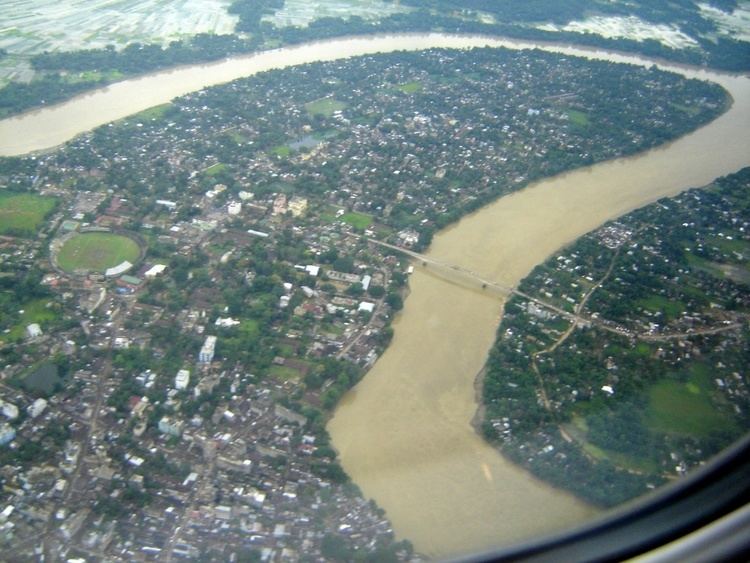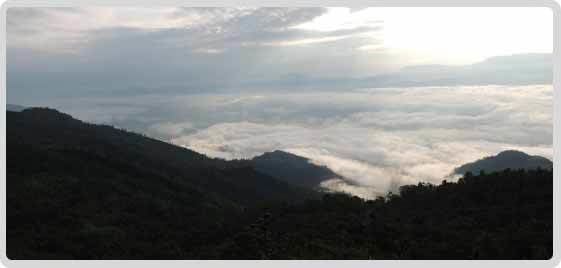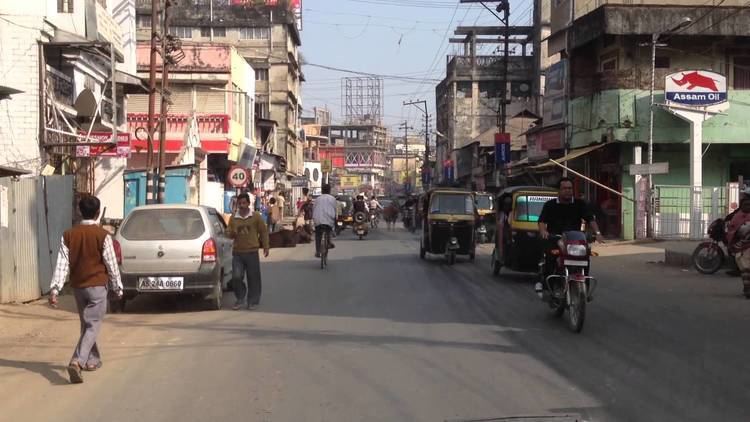Country Language spoken District | ||
 | ||
Colleges and Universities National Institute of Technology - Silchar, Assam University, Gurucharan College, Cachar College, Womens College - Silchar | ||
Map of Silchar
Silchar (/ˈsɪlˌʧə/ or /ˈʃɪlˌʧə/) is the headquarters of Cachar district in the state of Assam in India. It is 343 kilometres (213 mi) south east of Guwahati. It is the second largest city of the state in terms of population and municipal area.
Contents
- Map of Silchar
- Silchar hidden tourism place must watch new video of 2012 tuha and keshab
- Durga puja arati during sandhi puja at ramkrishna missionsilcharassamindia
- Etymology
- Cachar district records
- Railway link
- Language Movement in Barak Valley
- Economy
- Industries
- Geography
- Demographics
- Climate
- Schools
- University
- Technical Institutions
- Colleges
- Medical College
- BEd and Law colleges
- Healthcare
- Transportation
- Railways
- Roadways
- Airways
- Airlines and destinations
- Politics
- Sports facilities
- Media
- Tourist attractions
- Notable people
- References

It also has the 2nd busiest Airport (76 civilian flights/week) in Assam and 4th busiest in North east after Guwahati, Agartala and Imphal.

After around 68 years of Indian independence, only recently, the railroad connectivity has been upgraded to broad gauge. Suresh Prabhu, the present rail minister, has announced direct rail connectivity to metropolitan cities like New Delhi and Kolkata with regular train services having been commenced as planned.
Being politically stable in the otherwise disturbed Northeast earned it the bon mot of "Island of Peace" from India's then Prime Minister Indira Gandhi.
Approximately 80% residents of Silchar are Bengalis who speak the Sylheti dialect, the rest being Dimasa (barman), Meitei Manipuri, Bishnupriya Manipuri, Bihari people, Marwaris and some Nagas. Silchar is situated by the banks of the Barak River in what is popularly known as Barak Valley. Rice is the staple cereal. Fish is also widely consumed. Shuţki (the local name for dried fish), shidal chutney and chunga-r peetha (sticky rice cakes prepared inside bamboo sticks) are some of the local delicacies.
Silchar hidden tourism place must watch new video of 2012 tuha and keshab
Durga puja arati during sandhi puja at ramkrishna missionsilcharassamindia
Etymology
During the British rule, ships were docked at the bank of the river Barak. Gradually, a market developed at the bank and became a major place of economic activity. The bank was covered with stones to help dock ships and vessels, and the market was developed at a place that was fully covered with stones. People started to refer to the place as Shiler Chor, meaning "a bank of stones". With the passage of time, Shiler Chor was simplified to Silchar, and ultimately the British officials started to use the name Silchar in their official documents referring to the surrounding area of the market. Thus Silchar became the official name of the place.
Cachar district records
In the 1850s, British tea planters re-discovered the game polo in Manipur on the Burmese border with India. The first polo club in the world was formed at Silchar.
The first competitive modern form of polo was played in Silchar, the plaque for this feat still stands behind the District Library, Silchar.
Railway link
The Assam Bengal Railway brought Silchar into the Indian railway map in 1899. The railway line from Lumding to Silchar is hailed as one of the most exciting pristine railway tracks of India. Built by the British during the colonial rule, the meter gauge line stands testimony to the grandiose of what was once a highly popular city in the North-East. But in November 2015, a new broad gauge railway track was introduced by replacing meter gauge between silchar and guwahati.
Language Movement in Barak Valley
Silchar saw one of the uprisings in favour of the Bengali language. When the Assam government, under Chief Minister Bimala Prasad Chaliha, passed a circular to make Assamese mandatory, Bengalis of Barak Valley protested. On 19 May 1961, Assam police opened fire on unarmed protesters at Silchar railway station. Eleven martyrs had laid down their lives at Silchar Railway Station for the sake of their mother tongue Bengali.
After the popular revolt, the Assam government had to withdraw the circular and Bengali was ultimately given official status in the three districts of Barak Valley. Section 5 of Assam Act XVIII, 1961, safeguards the use of Bengali in the Cachar district. It says, “Without prejudice to the provisions contained in Section 3, the Bengali language shall be used for administrative and other official purposes up to and including district level.”
Every year on 19 May is celebrated as Bhasha Shahid Divas (ভাষা শহীদ দিবস) to commemorate those 11 martyrs who sacrificed their lives for the sake of protecting Bengali language, various cultural programmes are conducted, rallies are taken out and bust of those martyrs are decorated with flower garlands.
Economy
Over the past few years, the town has seen an influx of people from nearby States and places due to the Silchar's increasing prospects and other developments in the field of education, medical facilities etc. making the town quite over-crowded.
Industries
Geography
Silchar is located in the southern part of Assam. Situated on the banks of the Barak River, it is a trade and processing centre for tea, rice and other agricultural products. There is limited industry, principally papermaking and tea-box manufacturing. The city has an airport and is connecting to Kolkata, Guwahati, Agartala, Imphal, and Aizawl. Silchar is regarded as an important road junction of the North Eastern India and serves as a major point of connection for Tripura, Manipur and Mizoram.
The area of Silchar town is 15.75 km2. It has an average elevation of 25 meters (82 feet).
Demographics
As of 2011 India census, Silchar had a population of 178,865. Total number of males were 89,961 and females 88,904. The sex ratio of Silchar was 988 females per 1000 males, which is above the national ratio of 940 females per 1000 males. Silchar metropolitan region has an average literacy rate of 90.26%,higher than the national average of 84% (2017), with male literacy of 92.90% and female literacy at 87.59%. Hinduism is majority religion in Silchar city with 86.31% followers. Islam is second most popular religion in city of Silchar with approximately 12.17% following it. Jainism is followed by 0.79%, Christianity by 0.59%, Sikhism by 0.04% and Buddhism by 0.04% of the population in the Silchar city. Around 0.00% stated 'Other Religion', approximately 0.08% stated 'No Particular Religion'.
Climate
At Silchar, the climate is tropical by nature. The wind generally blows from the northeast in the morning and from the southeast in the afternoon. Summer is hot, humid and interspersed with heavy rainfall and thunderstorms. Winter generally starts towards the end of November and lasts till late February. Towards the start of the Bengali month of Baishakh (mid-April) rain clouds start covering the skyline. Silchar is inundated frequently due to excessive rainfall and floods by the River Barak. Over the last three decades, Silchar and the Barak Valley have been ravaged by four major floods - one in 1986, followed by the ones in 1991, 2004 and 2007.
Schools
The schools of Silchar are run by the state government and private organisations. Bengali and English are the primary languages of instruction; Assamese and Hindi are also used. The schools are affiliated to either Secondary Board of Education, Assam (SEBA) or the CBSE. Prominent schools of Silchar include:-
University
Silchar is home to the main campus of Assam University, a central university, which imparts education in both the general as well as professional streams. The university, which came into existence in 1994, has 16 schools and 35 post-graduate departments under them. The university has 56 affiliated colleges under it. The colleges in Silchar are mostly affiliated with the Assam university.
Technical Institutions
Dholchera campus is spread over 65 acres of land and the Jaffirbond campus covers 20 acres. NIAIMT is one of the significant initiative by Government of India under NATRiP for entire northeast area to implement modern infrastructure and facilities aiming to develop skills to handle the latest automobiles by providing training to the youths. This center has also created infrastructure to test in-use vehicle by applying latest technologies, thus making the roads safer.
Colleges
Medical College
B.Ed and Law colleges
Silchar also has:
Healthcare
Silchar has a number of good hospitals and nursing homes, some of them are as follows:
Transportation
Silchar is connected by road, railways and air to the rest of the country.
Railways
Silchar railway station falls under the jurisdiction of the Northeast Frontier Railway zone of the Indian Railways. The railway gauge functioned here is 1,676 mm (5 ft 6 in). The railway station is situated in Tarapur, Silchar.
The 1,676 mm (5 ft 6 in) conversion which includes the reconstruction of the railway station has been started from 1 October 2014 onwards as a part of the Lumding - Badarpur - Silchar railway section of the Northeast Frontier Railway zone of the Indian Railways.
Roadways
Regular bus services connect Silchar with Guwahati, Shillong, Aizawl, Agartala and Imphal through NH 37 and NH 53. However, during the rainy seasons, heavy downpour affects the Silchar-Shillong-Guwahati route causing frequent landslides which affects the road transportation. There is an Inter State Bus and an Inter State Truck Terminus which was constructed in the year 2005. The under construction four lane East - West corridor will connect Silchar in the east with Saurashtra in the west.
Airways
Silchar Airport (IXS) is located at Kumbhirgram, about 22 km from Silchar and there are regular daily flights connecting Silchar with Kolkata, Guwahati, New Delhi, Bengaluru & Dibrugarh. The airport is being modernised and is considered the fourth-busiest in north eastern India after Guwahati, Imphal and Agartala in terms of flight movements. Silchar has been selected as one of the towns for the construction of 51 low cost airports across the country recently.
In December 1985, Air India operated the first all-woman crew flight in the world from Kolkata to Silchar which was commanded by Captain Saudamini Deshmukh on a Fokker F-27 Friendship aircraft.
The airport has the following features:
- ILS (Instrumental Landing system) CAT-I system.
- 7500 feet runway, capable of handling up to Airbus 321/ Boeing 737-800 type crafts
- PAPI lights
- Night Landing Facility
- Apron can handle three A321/B737-800 crafts or 5 ATR-72 type crafts
Both Air India and JET Airways has stopped operating their ATR42/72 crafts and replaced them with Airbus 319 and Boeing 737-800 crafts from 2017. SpiceJet operates Q400 crafts from Silchar,
Airlines and destinations
- Air India operates daily silchar-kolkata (AI 753-754) flight
- Jet Airways Operates daily Bangalore-kolkata-silchar flight (from 1st Oct) and daily Delhi- gauwhati- silchar flight (9W 903/904)
- Spice Jet operates daily twice kolkata-silchar flight(SG 3213-3214/3219-3220) and daily Silchar-Gauwhati flight (SG 3213-3214)
Politics
Silchar is part of the Silchar (Lok Sabha constituency). The current member of Parliament from Silchar is Sushmita Dev who is the youngest daughter of the veteran politician Santosh Mohan Dev of the Indian National Congress.
Sports facilities
Satindra Mohan Dev Stadium is the only multipurpose stadium located at Silchar. The stadium has hosted an international one day match between the Indian and the England women's cricket teams. It has also hosted Ranji Trophy and Duleep Trophy matches. Among the major football competitions, Santosh Trophy and I-League 2nd Division matches have been hosted at the ground.
Silchar also has an Indoor Stadium which is also used mainly for indoor sports.
The Tennis Club, Silchar is the only facility for hosting tennis matches and has multiple synthetic courts. The club also has an academy for imparting training.
Media
Silchar has an All India Radio station known as Akashvani Silchar. It broadcasts on AM and FM frequencies. Silchar also has a terrestrial television transmission center and studio of India's national broadcaster Doordarshan, known as DD Silchar.
In the print media, a number of Bengali and English daily newspapers are published from the town. The major newspapers published from Silchar include Bengali dailies Dainik Jugasankha, Anandabazar Patrika, Dainik Abichar, Dainik Prantajyoti, Samayik Prasanga, Janakantha and the English dailies The Sentinel and Eastern Chronicle. Besides the local newspapers, national and regional dailies like The Telegraph, The Times of India, The Statesman, The Assam Tribune etc. are also available.
